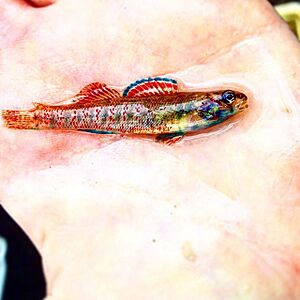Greenthroat darter facts for kids
Quick facts for kids Greenthroat darter |
|
|---|---|
 |
|
| from the Comal River, Texas | |
| Conservation status | |
| Scientific classification |
The greenthroat darter (Etheostoma lepidum) is a small, colorful ray-finned fish that lives in freshwater. It's a type of darter, which belongs to the same family as perches. You can find this fish in rivers and streams in parts of Texas and New Mexico, including the Colorado, Guadalupe, Nueces River, and Pecos River systems.
Contents
Where the Greenthroat Darter Lives
The greenthroat darter mostly lives in areas where springs flow into rivers and streams. It prefers clear water and can be found over different types of river bottoms, from solid rock to gravel and small stones.
These fish especially like rocky areas with fast-moving water, called riffles. They are often found where there are also aquatic plants. Sometimes, they live in cool, plant-filled pools near springs. The largest groups of greenthroat darters are usually found in rocky riffles that have lots of plants. After they hatch, young darters tend to stay close to the bottom of the stream.
Greenthroat Darter Life Cycle
When Greenthroat Darters Lay Eggs
Greenthroat darters usually lay their eggs from October or November through May. In places where the water temperature stays very steady, they might have a longer egg-laying season. For example, in the Colorado River in Texas, they lay eggs from November to May. In the South Concho River, Texas, it's from October to May. Studies have shown that if the water gets too warm, around 23 degrees Celsius (73 degrees Fahrenheit), they lay fewer eggs.
Where Greenthroat Darters Lay Eggs
These fish lay their eggs on plants or on the underside of rocks in the water.
How Many Eggs They Lay
In the South Concho River, Texas, the eggs are about 1.3 millimeters wide. Bigger female darters usually lay more eggs. On average, females lay about 74 eggs, but some can lay as few as 15 or as many as 200.
In aquariums, scientists have watched greenthroat darters lay eggs when the water temperature was between 15 and 25 degrees Celsius (59-77 degrees Fahrenheit). One pair of darters laid 13 groups of eggs over 63 days, totaling 1,115 eggs! The best temperature for them to lay eggs seems to be between 20 and 23 degrees Celsius (68-73 degrees Fahrenheit). One female kept at this temperature laid eggs for at least 251 days in the lab.
It's harder for the eggs to hatch if the water temperature goes above 24 degrees Celsius (75 degrees Fahrenheit). At 28 degrees Celsius (82 degrees Fahrenheit), eggs hatch in about 4 to 5 days. But if the water is cooler, around 9 degrees Celsius (48 degrees Fahrenheit), it can take about 40 days for them to hatch. The amount of daylight doesn't seem to affect how many eggs they produce.


